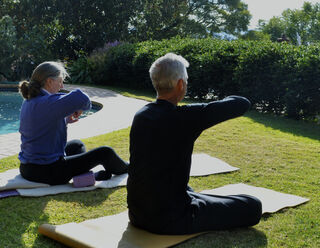Sex
Rehabilitation for Men Recovering From Prostate Cancer
Part I: Here's a practical way to support healthy recovery.
Posted June 1, 2021 Reviewed by Lybi Ma
Key points
- Men impacted by erectile dysfunction (ED) can safeguard the long-term health of erectile tissue using rehabilitation methods.
- Particularly for prostate cancer survivors, regular physical stretching and oxygenation of the affected tissues is a healthy routine.
After prostate cancer treatment, nearly all men suffer temporary or long-term erectile dysfunction. To keep the possibility of recovery alive, some active housekeeping is needed, in the form of penile rehabilitation. Medically, such rehab directly addresses the biggest danger to long-term erectile function (ED) arising from prostate cancer surgery: atrophy of erectile tissues.
Penile rehabilitation exercises also promise to help with sexual function. It takes some practice and communication to get over the awkwardness. It feels weird to apply mechanical exercise around an intimate activity that we expected to be spontaneous.
The missing link in pre- and post-operative care
I should have been properly briefed about penile rehab before my surgery, and started preparing even before my treatment began. Instead, I was stuck with the dilemma of being told (about my non-existent erection) "use it or lose it."
With the impact of neuropraxia (nerves recoiling from the heat and light and something like bruising during laparoscopic surgery), I was completely unable to find the elusive erection I'd been told to use.
There was an alarming missing link in the information I received from my urologist and surgeon. And embarrassment makes it harder to ask questions. My doctors seemed almost more afraid to talk about matters of sexual function than I was.
The medical basis for "use it or lose it"
Here's what I now know after a lot of research: My ED condition leaves my previously dependable old friend down below subject to "reduced oxygenation and subsequent structural changes in penile tissue." Without the blood flow that comes with erections, basically, my penis will permanently atrophy. Also, without such rehabilitation, more men experience a significant loss in penile length and girth after prostate cancer treatment.
Men lose 2000 spontaneous nocturnal erections a year after prostate surgery
"My" kind of surgically induced erectile dysfunction is more deadly for the erectile tissue than ED from other natural causes. This is because nerve damage also breaks the natural cycle of spontaneous nocturnal erections.
Spontaneous nocturnal erections occur several times a night regardless of whether we are sexually active in our conscious daytime lives. Women also have spontaneous nocturnal clitoral erections as part of their body's natural housekeeping function for erectile tissue. We typically aren't aware of what is happening down there while we are sleeping, except that men's "morning wood" tends to be more obvious.
The erections we don't know about, in the depths of sleep time, are not about erotic events. They are essential natural housekeeping for erectile tissues. Without this form of regular oxygenation, erectile function is permanently lost.
I was alarmed to learn from Dr. Jo Milios that after prostate cancer surgery, men lose 2000 of these unconscious nocturnal tissue-regenerating erections a year. Those who opt for radiation treatment are usually better off for the first few years but tend to end up with similar problems within five years.
Drug independent rehabilitation treatment
I was on daily breakfast with Cialis for many months before learning that there was more I could do in parallel with PDE5 medication. There is strong evidence for the value of Vacuum Erectile Devices (VEDs) in penile rehabilitation with or without parallel PDE5 medication.
My third month after radical prostatectomy was by far the worst from an erectile dysfunction (ED) point of view, and my ongoing daily dose of Cialis wasn't helping in any way I can detect. My surgeon didn't have much more to offer.
Then I got the VED recommendation on the very practical Australian website ATouchySubject. Amazing information to get from halfway around the world: The Vacurect device turns out to have been designed, developed, and manufactured about 60 kilometres from my home in South Africa. (For the background, please see a remarkable personal and business story of innovation and recovery from all kinds of adversity.)
Immediate positive results
From a medical perspective, I was thrilled at the new life the Vacurect brought to me. Right out of the box, I was able to use this medical-grade device to literally pump up my erection, flushing the tissues with life-giving blood and allaying my fears of penile atrophy, shrinkage, and even the radical bending that comes with Peyronie's Disease.
A pathway towards regaining sexual function
From a sexual perspective, my first attempts with the Vacuum Erectile Device (VED) were not exactly thrilling. When I mentioned my latest purchase to my wife, she was encouraging, from a bit of a distance. I was shy about it.
It's a long way from the fantasy of spontaneous uncomplicated sex. The device feels awkward and the first time I brought it into the bedroom the results were underwhelming. With so much focus on the mechanics, all erotic thoughts disappeared and even the pump couldn't revive my flagging erection.
Taking myself in hand without shame
The GP who saved my life with my cancer diagnosis gave me this down-to-earth advice the week after my surgery: "masturbate at least twice a week." For months after surgery that was physically difficult, but not impossible, without an erection.
Yet, they say, "use it or lose it."
The VED makes it all a whole lot easier. Practicing solo emerged as my first step back towards regaining sexual function. Perhaps my cancer recovery will finally banish whatever vestiges of masturbation shame that still dance around my psyche.
I was scared that practicing solo would usurp the joy of marital intimacy. My wife and I committed to exploring new forms of intimacy that don't depend on erectile function. Before my cancer, we already believed we were good at this. With ED, it proved more difficult than we expected. More about our laughs, fumbles, and learning in a future post.
Like a new form of yoga practice

For more than 10 years, my wife and I have been practicing a daily yoga routine in our backyard. This stretching and exercise have brought enormous health benefits to our whole bodies and spirits and our relationship.
The penile rehab I have described above is analogous to yoga. It is also a regular stretching and exercise practice, only focused on this one body part suffering from nerve damage after prostate cancer surgery. Now I have a rehab routine that is like a new yoga therapy for my ED.
For obvious reasons, the illustration is not included here. Penile rehab exercises are awkward, but then I found the other kind of yoga (illustrated here) pretty awkward when we started.
Practice makes perfect.
This post also appears at recoveringman along with more of my personal and medical backstory.
References
Please see my low-down guide to using the Vacurect in practice.
Dean, R. C., & Lue, T. F. (2005). Neuroregenerative strategies after radical prostatectomy. Reviews in urology, 7 Suppl 2, S26–S32.
Fode, M., Ohl, D.A., Ralph, D. & Sønksen, J. (2013). Penile rehabilitation after radical prostatectomy: what the evidence really says. BJU International, 112(7), 998-1008
Potosky, A.L. et al (2004). Five-Year Outcomes After Prostatectomy or Radiotherapy for Prostate Cancer: The Prostate Cancer Outcomes Study. JNCI: Journal of the National Cancer Institute, 96(18),1358–1367
Hoyland, K., Vasdev, N., & Adshead, J. (2013). The use of vacuum erection devices in erectile dysfunction after radical prostatectomy. Reviews in urology, 15(2), 67–71.




